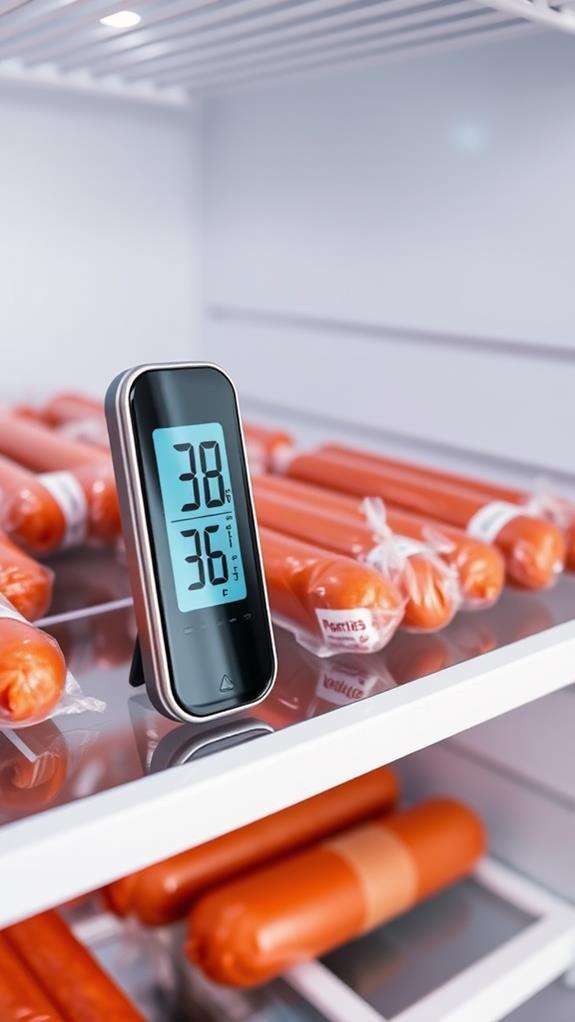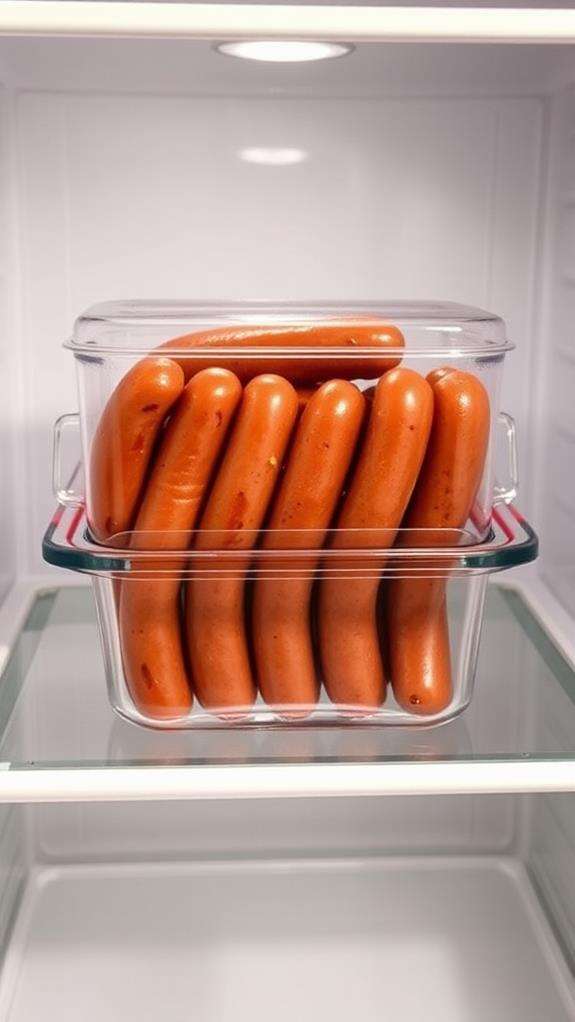How Long Does Smoked Sausage Last in the Fridge
Smoked sausage's shelf life in your fridge depends on whether it's opened or unopened. You'll get 3-4 days of freshness from opened smoked sausage when properly stored at or below 40°F (4°C), while unopened packages can last up to 2 weeks. For ideal storage, keep your sausage in airtight containers or vacuum-sealed bags in the back of your refrigerator where temperatures remain most consistent. You'll know it's spoiled if you notice any gray or green discoloration, slimy texture, or sour odors. To maximize longevity, you can freeze smoked sausage for up to 6 months – and there's more to know about proper storage techniques to keep your sausages at their best.
This post may contain affiliate links. If you make a purchase through these links, I may earn a commission at no additional cost to you. Additionally, portions of this post may be generated using artificial intelligence (AI) technology. While we strive for accuracy, please be aware that AI-generated content may not always be perfect and should be fact-checked when necessary.
The Spatula Scoops
- Properly stored smoked sausage typically lasts 1-2 weeks in the refrigerator when kept at or below 40°F (4°C).
- Vacuum-sealed smoked sausage can last up to 3 weeks in the fridge due to reduced bacterial exposure.
- Once opened, smoked sausage should be consumed within 7 days while maintaining proper refrigeration temperatures.
- Signs of spoilage include slimy texture, off-smells, discoloration, or mold growth, indicating the sausage should be discarded.
- For extended storage beyond 2 weeks, freeze smoked sausage where it can last up to 6 months.
Types of Smoked Sausage

Different types of smoked sausage come from across the world, ranging from German bratwurst to Polish kielbasa to American andouille. You'll find that each variety has its unique smoking process, seasoning blend, and meat composition, making them distinctly different in both taste and texture.
When you're exploring smoked sausage varieties, you'll encounter fully cooked options like hot dogs and bologna, which have been both smoked and heat-treated. There's also dry-cured smoked sausage, such as Spanish chorizo and Italian soppressata, which undergo a lengthy aging process after smoking. Semi-dry varieties, including summer sausage and mettwurst, offer a middle ground between fully cooked and dry-cured options.
The meat content varies markedly among types. You'll discover some made purely from pork, while others combine beef and pork, and some incorporate poultry. The smoking method also differs, with cold smoking (below 90°F) producing a more subtle flavor, and hot smoking (above 165°F) creating a more intense taste. Understanding these variations isn't just about appreciation—it's vital for proper storage and determining shelf life in your refrigerator.
Safe Storage Temperatures

Maintaining proper temperature control stands as the most critical factor in preserving your smoked sausage's safety and quality. You'll need to keep your refrigerator at or below 40°F (4°C) to prevent harmful bacteria growth, which can occur rapidly in the "danger zone" between 40°F and 140°F (4°C-60°C).
When you're storing smoked sausage, don't rely on your fridge's preset temperature. Instead, use a reliable refrigerator thermometer to monitor the actual temperature, as door openings and outside temperatures can cause fluctuations. Place your sausage in the back of the fridge, where temperatures remain most stable, rather than in the door compartments where they'll be exposed to warm air each time you open the fridge.
If you've purchased commercially vacuum-sealed smoked sausage, you can store it unopened at temperatures between 35-40°F (2-4°C). Once you've opened the package, you'll need to maintain strict temperature control and either consume the sausage within the recommended timeframe or repackage and freeze it at 0°F (-18°C) for longer storage. Remember, temperature consistency is key to maintaining both safety and flavor.
Proper Storage Methods

To keep your smoked sausage at its best, you'll need to store it properly using either an airtight container with a tight-fitting lid or vacuum-sealed packaging, which helps prevent moisture loss and bacterial growth. Your refrigerator's temperature should be consistently set between 34-38°F (1-3°C), with smoked sausages placed toward the back of the shelf where temperatures remain most stable. For maximum freshness and longevity, you can use a vacuum sealer to remove all air from the packaging before storage, extending the sausage's shelf life by up to 50% compared to conventional storage methods.
Airtight Container Usage Tips
Proper airtight container storage plays an essential role in extending your smoked sausage's shelf life. You'll want to choose containers that create a complete seal to prevent bacterial growth and protect against freezer burn. When selecting your storage container, opt for food-grade plastic or glass containers with secure, well-fitting lids that won't allow air to seep in.
- Always clean and dry your container thoroughly before storing smoked sausage to prevent contamination
- Check the container's seal by filling it with water and turning it upside down – if it leaks, don't use it for storage
- Leave about 1/2 inch of headspace in the container when storing to allow for slight expansion
- Label your container with the storage date using a permanent marker or adhesive label
- Consider using vacuum-sealed bags as an alternative to rigid containers for maximum freshness
If you're storing multiple sausages, don't stack them too tightly in the container. Instead, layer them with wax paper or parchment paper between each piece to prevent sticking and guarantee even cooling. Remember to inspect your containers regularly for cracks, warping, or damage that might compromise their airtight seal.
Optimal Temperature Settings
Inside your refrigerator, smoked sausage requires consistent temperatures between 35-40°F (1.7-4.4°C) for suitable storage. You'll want to place your sausage in the main compartment of your fridge, avoiding the door shelves where temperatures tend to fluctuate with frequent opening and closing.
To maintain peak temperatures, don't overfill your refrigerator, as this can restrict airflow and create warm spots. Consider using a refrigerator thermometer to monitor the temperature accurately, placing it in different zones to identify any inconsistencies. If you notice temperature variations above 40°F, adjust your fridge's settings accordingly.
The bottom shelf of your refrigerator typically maintains the most stable temperature and is suitable for storing smoked sausage. However, you'll need to make sure it's in a sealed container to prevent cross-contamination with other foods. If your fridge has a meat drawer, that's another excellent option, as these compartments are designed to maintain slightly cooler temperatures than the main compartment. Remember to check your refrigerator's temperature at least once weekly, especially during summer months when ambient temperatures can affect your appliance's performance.
Vacuum Sealing Methods
Vacuum sealing represents one of the most effective methods for extending your smoked sausage's shelf life. When you properly seal your sausages, you'll create an airtight environment that notably reduces bacterial growth and prevents freezer burn. You'll need a reliable vacuum sealer and appropriate food-grade bags to get started.
Here's what you need to know about vacuum sealing your smoked sausages:
- Pre-cool your sausages completely before sealing to prevent moisture condensation inside the package
- Use heavy-duty, BPA-free vacuum bags designed specifically for food storage
- Double-seal the edges to guarantee an airtight closure that won't fail during storage
- Label each package with the date of sealing and contents for easy identification
- Consider portion-sizing your sausages before sealing to avoid repeated opening and resealing
When you're ready to seal, place the sausages in a single layer within the bag, leaving about three inches of space at the top for proper sealing. Make sure there aren't any wrinkles in the bag where air could become trapped. You'll want to remove as much air as possible during the sealing process, as oxygen is the primary catalyst for food spoilage.
Signs of Spoilage

When checking your smoked sausage for spoilage, you'll want to look out for key visual indicators like discoloration, particularly gray, green, or brown patches, as well as any signs of mold or slimy surface texture. Your nose can be one of the best tools for detecting spoiled sausage, as any sour, rancid, or unusually funky odors suggest it's time to toss the meat. If you're still unsure, gently press the sausage to check its firmness, as spoiled sausage often feels sticky or slimy to the touch, and any significant changes in texture from when you first stored it should raise immediate concerns.
Visual Warning Signs
Visual inspection serves as your first line of defense against spoiled smoked sausage. When you're examining your sausage, you'll want to look for any obvious signs of deterioration that indicate it's no longer safe to eat. The surface of fresh smoked sausage should maintain a consistent color without any unusual discoloration or patches.
Here are the key visual indicators that your smoked sausage has gone bad:
- Moldy patches appearing as fuzzy or powdery spots in white, green, or black colors
- A slimy film or coating on the surface, which can appear clear or slightly yellowish
- Significant color changes, especially gray or brown areas that weren't present when purchased
- Dried-out or shriveled sections that indicate moisture loss and aging
- Dark or discolored spots that suggest bacterial growth
You shouldn't ignore any of these warning signs, even if they appear minor. When in doubt, it's better to err on the side of caution, as consuming spoiled sausage can lead to food poisoning. If you notice any of these visual indicators, you should dispose of the sausage immediately, regardless of its printed expiration date.
Smell and Texture Changes
Beyond visual cues, smell and texture changes provide essential indicators of spoiled smoked sausage. You'll want to rely on your senses to detect any concerning changes that signal it's time to discard the product.
| Smell Indicator | Texture Change |
|---|---|
| Sour, acidic odor | Slimy surface |
| Fermented smell | Mushy spots |
| Rancid aroma | Dried, cracked areas |
| Chemical scent | Sticky residue |
When examining your smoked sausage, you'll need to unwrap it and perform a smell test. Fresh smoked sausage should have a pleasant, smoky aroma with subtle meat undertones. If you detect any off-putting smells, particularly those similar to vinegar or chemicals, your sausage has likely spoiled. The texture should remain firm and slightly moist but never slimy. Run your finger across the surface – if it feels tacky or leaves a residue, that's a clear sign of bacterial growth. You'll also want to check for any spots that feel unusually soft or areas that have become overly dry and brittle, as these indicate improper storage conditions and potential spoilage.
Extending Shelf Life

Several proven methods can help maximize your smoked sausage's refrigerator life. When you're storing these flavorful meats, proper handling and storage techniques make a significant difference in preservation duration and quality maintenance. For instance, using food storage containers specifically designed for meat can enhance their longevity.
- Store your smoked sausage in an airtight container or vacuum-sealed bag, removing as much air as possible to prevent oxidation and bacterial growth.
- Keep the refrigerator temperature consistently at or below 40°F (4°C), using a thermometer to monitor conditions.
- Place the sausages in the back of your refrigerator where temperatures remain more stable, rather than in the door compartment.
- Wrap unopened factory-sealed sausages in aluminum foil or freezer paper for an additional protective barrier against moisture and light.
- Use designated meat drawers when available, as they're designed to maintain ideal humidity levels for meat preservation.
You'll also want to utilize the original packaging until you're ready to use the sausage, as it's specifically designed for ideal preservation. If you've purchased bulk quantities, consider freezing portions you won't consume within the recommended refrigeration timeframe. Remember to label containers with the storage date to track freshness effectively.
Freezing and Thawing Guidelines

When it comes to long-term storage, freezing your smoked sausage offers an excellent preservation method that can extend its life up to 6 months. You'll want to wrap your sausages properly in freezer paper or heavy-duty freezer bags, removing as much air as possible to prevent freezer burn.
| Temperature | Thawing Method | Approximate Time |
|---|---|---|
| 35-40°F | Refrigerator | 24-48 hours |
| 70°F | Cold Water | 1-2 hours |
| 70°F | Microwave | 2-3 minutes |
| Room Temp | Not Recommended | N/A |
| Below 32°F | Keep Frozen | Up to 6 months |
To thaw your frozen smoked sausage safely, you've got several options, but the refrigerator method is your best bet. Place your frozen sausage in the fridge and allow 24-48 hours for complete thawing. If you're in a hurry, you can use the cold water method by submerging the sealed package in cold water, changing the water every 30 minutes. While microwave thawing is possible, it's not ideal as it can lead to uneven heating and affect the texture. Never thaw sausage at room temperature, as this can promote bacterial growth.
Frequently Asked Questions
Can I Eat Smoked Sausage Straight From the Package Without Cooking It?
Whether you can eat smoked sausage straight from the package depends on how it's processed. Fully cooked smoked sausage (like hot dogs or kielbasa) is safe to eat without additional cooking, but you'll want to check the package label to confirm. However, if it's a raw smoked sausage, you must cook it first. For the best flavor and food safety, you'll often want to heat even pre-cooked smoked sausages before eating.
Does Vacuum-Sealed Smoked Sausage Need to Be Refrigerated Before Opening?
Like a ticking time bomb, vacuum-sealed smoked sausage needs proper storage to stay safe. Even though it's sealed, you'll need to refrigerate it before opening. While some commercially sealed products are shelf-stable at room temperature, it's best to keep your smoked sausage in the fridge to prevent bacterial growth. If you're unsure, check the package label – it'll tell you if it's shelf-stable or needs refrigeration.
Can I Refreeze Smoked Sausage After Thawing It in the Fridge?
You can safely refreeze smoked sausage that's been thawed in the refrigerator, but you'll notice some loss in quality. Since you've thawed it slowly in the fridge (rather than on the counter), the meat's still safe to return to the freezer. However, you might experience a slight change in texture and moisture content. For best results, try to use your thawed sausage within 1-2 days instead of refreezing it.
Why Does Some Smoked Sausage Have a White Powdery Coating?
That white powdery coating you're seeing on your smoked sausage is actually a harmless substance called penicillium. It's a beneficial mold that naturally develops during the curing process and helps protect your sausage from harmful bacteria. You'll often see this on dry-cured sausages like salami or chorizo. Don't worry – it's completely safe to eat and actually contributes to the sausage's distinctive flavor and aroma.
Should Smoked Sausage Be Stored in Original Packaging or Rewrapped After Opening?
Have you ever wondered about the best way to store your opened smoked sausage? Once you've broken the original packaging's seal, you'll want to rewrap your sausage tightly in plastic wrap or aluminum foil, or store it in an airtight container. While the original packaging works great for unopened sausage, it won't provide adequate protection after opening. You'll maintain freshness and prevent cross-contamination by properly rewrapping your smoked sausage.





